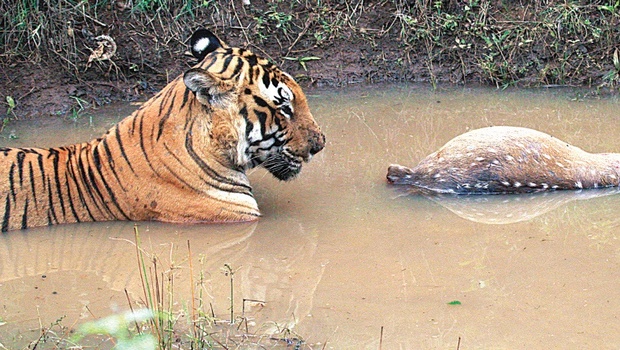Increasing Tiger Density in Karnataka Heightens Infighting Risks

BENGALURU: Increasing numbers are welcome. But Karnataka is seeing tigers fight tooth and claw for space. However, officials and experts feel space constraint is not the only factor causing tiger deaths.
Even as 700 experts, scientists and officials debate and discuss on the conservation issues in the third Asia Ministerial Conference on Tiger Conservation at New Delhi, Karnataka's two reserves -- Bandipur and Nagarhole -- home to the highest tiger population and density in the world, are in a quandary.
With the increasing tiger population and density in the protected areas of Karnataka, the natural phenomenon of fight for space between the big cats has been on the rise in these reserves. These two reserves today are home to 177 animals based in an area of 1,516 sqkm.
Between August 2015 and March 2016, five tigers have died. Of them, three were found dead in clear cases of infighting. Another tiger was found dead at D B Kuppe Range, Nagarhole, due to severe injuries sustained while being chased by a leopard. However, another animal, a man-eater that had killed three people, was killed at Hediyala Range, Bandipur.
Speaking to Express, N C Kantharaju, Director of Nagarhole National Park, said two tigers in Nagarhole and one in Bandipur died in incidents of fighting with other big cats.
He adds, "Presently, both the reserves have a high density and population of tigers with 72 and 105 tigers in Nagarhole and Bandipur respectively. Since we have a healthy and sufficient prey base, they are getting enough food. Tiger feeds on one animal per week and needs 52 animals per year. The prey is plenty."
As far as tiger density is considered, there is one tiger per 9 sqkm in Bandipur while one per 8 sqkm at Nagarhole. The director adds, "There are no space constraints despite the high density of animals. Time and again, they spill over to BRT or to Tamil Nadu. Since the prey availability is healthy, I don't feel they need more space or area."
Experts say three to four tigers killed in these two reserves is because of intra-specific aggression -- aggressive encounters among animals of the same species.
According to noted Dr Ullas Karanth, Director- Science Asia, Wildlife Conservation Society, "Intraspecific aggression like fighting for mates, space or prey, is common among big cat populations. The numbers reported seem reasonable given that Bandipur-Nagarhole tiger population is likely to lose 20 or more animals on an average per year due to various causes. Not all wild tiger deaths are detected. So this is only a fraction of the expected number of deaths."
These two reserves have been at high densities for over two decades now and do they need additional protected space adjoining them?
Dr Karanth explains, "The levels of aggression vary as densities naturally fluctuate to some extent. We should not attempt to raise tiger densities further in these reserves. What we should try to do is to recover other areas with depressed prey densities to accommodate more tigers. And yes, more tigers will lead to more conflict with humans on the edges that need to be managed too".